Construction of the Mike O'Callaghan - Pat Tillman Memorial Bridge (Hoover Dam bypass bridge) is now complete! This bridge is the central portion of the Hoover Dam Bypass Project. Construction on the nearly 2,000 foot long bridge (with a 1,060 foot twin-rib concrete arch) began in late January 2005 and traffic began using the Hoover Dam Bypass on October 19, 2010. This signature bridge spans the Black Canyon (about 1,500 feet south of the Hoover Dam), connecting the Arizona and Nevada Approach highways nearly 900-feet above the Colorado River.
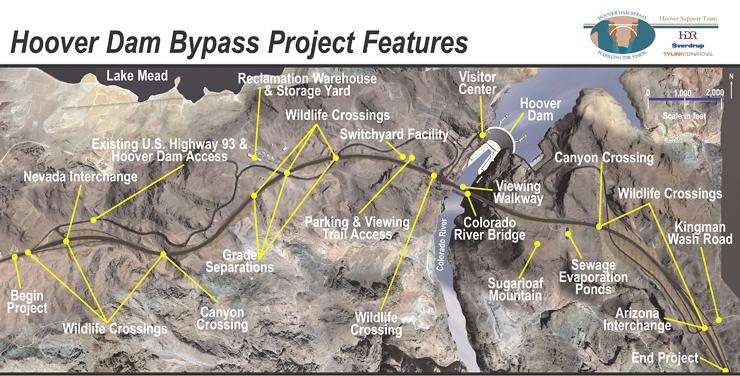
Map of Hoover Dam Bypass Bridge Project

Architect Rendering of Hoover Dam Bypass Bridge
Timelapse video of the new bridge under construction
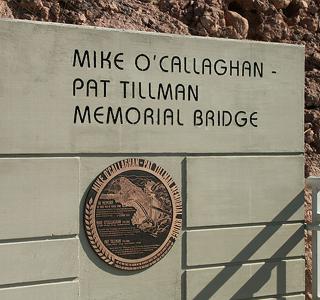
The bridge visitors area has a number of Informational Panels explaining the details about the bridge. You can see them here.
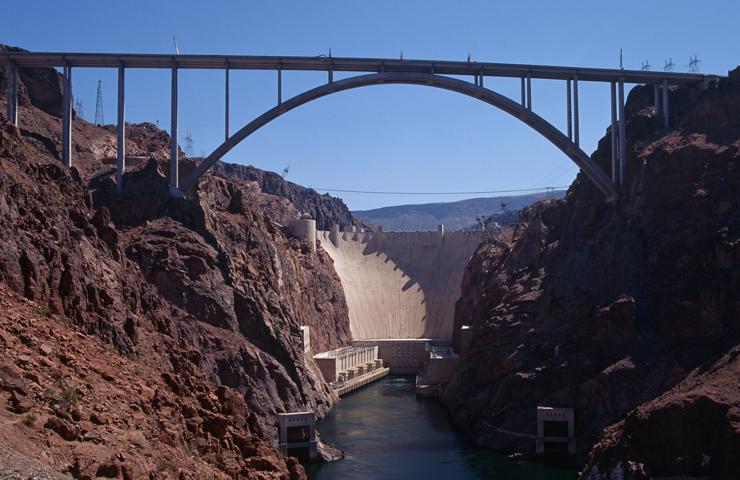
The Mike O'Callaghan-Pat Tillman Memorial Bridge from downstream of the Hoover Dam in July 2010.
Construction of Hoover Dam was started in 1931 and used enough concrete to build a road from New York to San Francisco. The stretch of water it created, Lake Mead, is 110 miles long and took six years to fill. The original road was opened at the same time as the famous dam in 1936.
The Mike O'Callaghan–Pat Tillman Memorial Bridge, known as the Hoover Dam Bypass during planning and early construction, provides a bridge connecting roads for a new route across the Colorado River for U.S. Route 93. The project links the States of Nevada and Arizona by spanning the Colorado River 1,600 ft (490 m) downstream from the Hoover Dam.
The bridge opened to traffic on October 19, 2010. It was built within budget at a cost of $240 million. The existing roadway across Hoover Dam has been closed to through traffic.
Mike O'Callaghan – Pat Tillman
Memorial Bridge
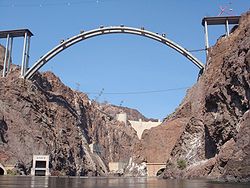
The bridge as seen from a boat on the Colorado River south of the site in September 2009
Crosses
Design
Total length
Height
Longest span
Completion date
Coordinates
Colorado River
Concrete-steel composite arch bridge
1,900 ft (580 m)
890 ft (270 m)
1,080 feet (329 m)
November 2010 (projected)
36°0'45"N 114°44'29"W
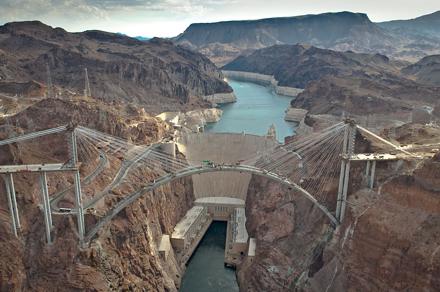
Looking northeast as the two halves of the arch are joined - August 2009
NOTE in the picture above: The top of the white band of rock in Lake Mead is the old waterline prior to the drought and development in the Las Vegas area. It is over 100 feet above the current water level.
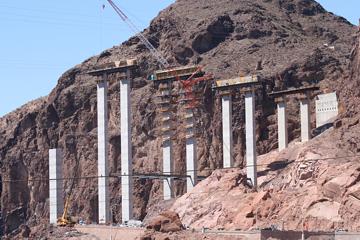
Looking west toward the Nevada side of the canyon at construction of the Nevada approach March 28, 2007.
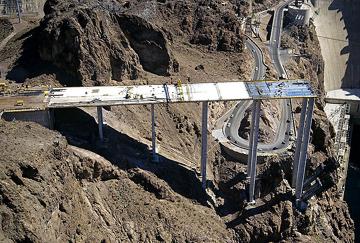
The west approach is 328 feet (100 meters) high
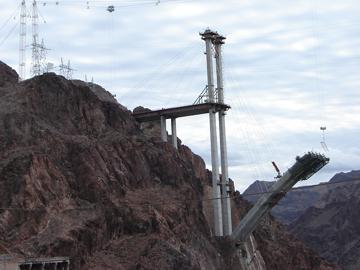
Construction of the arch underway on the Arizona side December 16, 2008
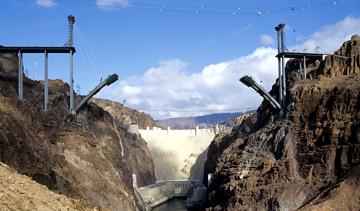
December 2008 view of the Hoover Dam Bypass Bridge
Left side of the picture - The Arch, constructed to segment 10, from the Nevada skewback. Forestay cables span from the Arch ribs to the temporary pylons above Pier 5 and backstays span between the head and the backstay anchor block.
Right side of the picture - The Arch, constructed to segment 10, from the Arizona skewback. Forestay cables span from the Arch ribs to the temporary pylons above Pier 5 and backstays span between the head and the backstay anchor block.
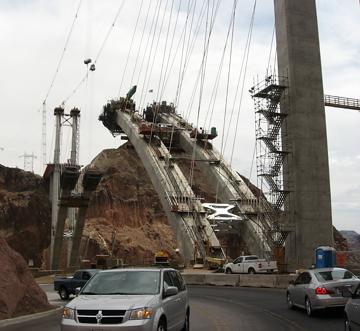
Arch construction viewed from the existing US 93 road
April 10, 2009
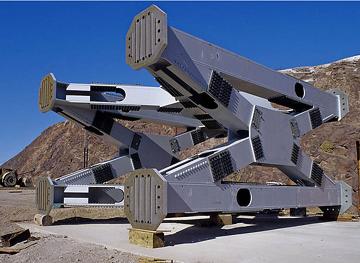
Several huge steel struts were placed at intervals between the two concrete ribs
Justification for a new bridge
The bypass was constructed to improve safety, security, and traffic capacity. Through extensive studies this bridge was determined to be the best route for the bypass.
U.S. Highway 93 (in conjunction with U.S. Highway 60 via Wickenburg, Arizona) is the primary link between Phoenix and Las Vegas, two cities that have seen population explosions since the Hoover Dam's completion.
The section of U.S. 93 that approached and crossed Hoover Dam is not adequate for modern traffic needs. It is narrow, one lane in each direction, has many dangerous curves, including several hairpin turns, and has poor sight distances especially at night. Combined with sightseeing and pedestrian traffic at the dam, traffic often came to a standstill.
As a consequence of the heightened security measures following the September 11, 2001 attacks, truck traffic over the Hoover Dam had been diverted south to a river crossing near Laughlin, Nevada, in an effort to safeguard the dam from hazardous spills or explosions.
This disruption, however, had not eliminated the threat of a possible attack on the dam, as regular traffic still passed over it. The bypass and the bridge are therefore intended to improve travel times, replace the dangerous roadway, and reduce the possibility of an attack or accident at the dam site.
More than 17,000 cars and trucks are expected to use the new bridge daily, a number expected to grow by 50 percent over the next 20 years. It is a key component of the proposed Interstate 11 project.
Design
The bridge and the new sections of U.S. Highway 93 are four lanes wide. Total length of the bridge is 1,900 feet (579 m) with a 1,080 ft (330 m) main span. The roadway is 840 ft (260 m) above the river.
It is the first concrete-steel composite arch bridge built in the United States. The twin arch ribs are connected by steel struts. The composite design, using concrete for the arch and columns with steel construction for the roadway deck, was selected for schedule and cost control while still being aesthetically compatible with Hoover Dam.
Pedestrians are able to park and walk across the bridge for views of the Hoover Dam, but the dam is not visible to most drivers on the bridge.
Building the bridge and bypass roads
The largest obstacle to the project was the river crossing itself. The bridge and the bypass were constructed by a consortium of different government agencies and contractors, among them the Federal Highway Administration, the Arizona Department of Transportation, and Nevada Department of Transportation.
The master design is by HDR, Inc. T.Y. Lin International designed the bridge and Sverdrup Civil, Inc. (the successor to Sverdrup & Parcel that is now a subsidiary of Jacobs Engineering Group) designed the approaches.
Construction required hoisting workers and up to 50 tons of materials 890 feet (270 m) above the Colorado River using 2,300 ft (700 m)-long steel cables held aloft by a "high-line" crane system.
The arches are made of 106 pieces -- 53 per arch -- mostly cast-in-place 24 ft (7.3 m) at a time.
Milestones
July 1998
Planning and environmental work is completed and the environmental impact statement is issued.
July 2001
Design of the preferred alternative begins.
2003
Work begins on the approaches in both states.
October 2004
The construction contract for the arch bridge is awarded.
In late 2004, the bridge name honoring Mike O'Callaghan and Pat Tillman was announced at a ceremony by Nevada governor Kenny Guinn and Arizona governor Janet Napolitano.
O’Callaghan was a decorated Korean War veteran and was governor of Nevada from 1971 to 1979. He served as executive editor at the Las Vegas Sun newspaper. He suffered a heart attack and died on March 5, 2004.
Tillman was an Arizona State University and Arizona Cardinals football player who gave up his multi million-dollar career in the National Football League to enlist in the U.S. Army, and was killed by friendly fire in Afghanistan.
September 2006
Strong wind gusts across Black Canyon on September 15, 2006 appear to be the cause for the collapse of the "high-line" crane system used to carry people and materials at the bridge site. Fortunately, there were no injuries as a result. Limited work resumed in October 2006, but the cranes' collapse caused a two-year construction delay.
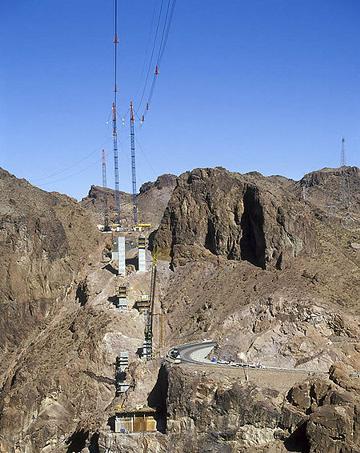
An early construction view with the original highline towers before they collapsed
March 2008
The approach spans were completed, consisting of seven pairs of concrete columns -- five on the Nevada side and two on the Arizona side. The spans acted as the springboard for the remaining segments, with two more cable towers built on them to complete construction of the bridge.
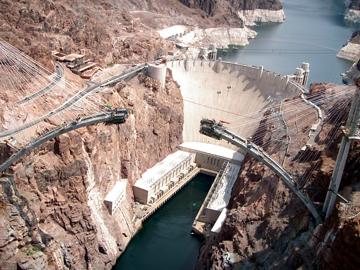
Construction of the arch moves steadily toward the center
May 21, 2009
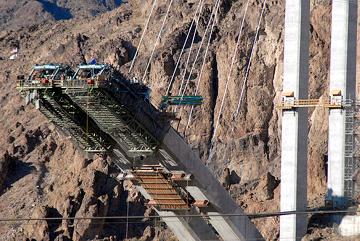
Two of the four form travelers used to create the two massive arch ribs - Steven Miller photo
May 2009
The concrete arch 50% completed, and on track for closure in the third quarter of 2009. Most of the arch segments have been cast in place using a temporary form traveler system. Other completed work includes the precast segments for the bridge columns which will support the roadway on the arch.
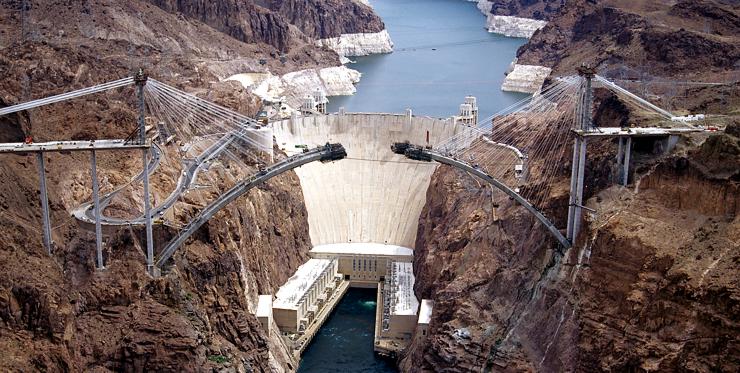
Construction of the arch steadily progressing - June 8, 2009
Left side of the picture – In Nevada, both ribs of the Arch are constructed to segment 22. The form travelers are launched out to segment 23 with forestays installed to segment 20.
Right side of the picture - In Arizona, both ribs of the Arch are constructed to segment 22. The left form traveler is launched out to segment 23 with forestays installed to segment 20.
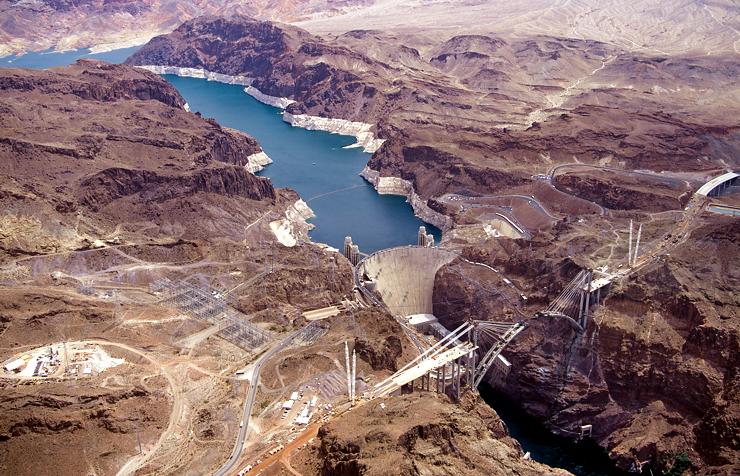
View of the Mike O'Callaghan-Pat Tillman Memorial Bridge with Hoover Dam and Lake Mead in the background - June 8, 2009.
August 2009
The twin arch spans were closed with the casting of the center segments. With the removal of the temporary cable stays, the arch is self supporting.
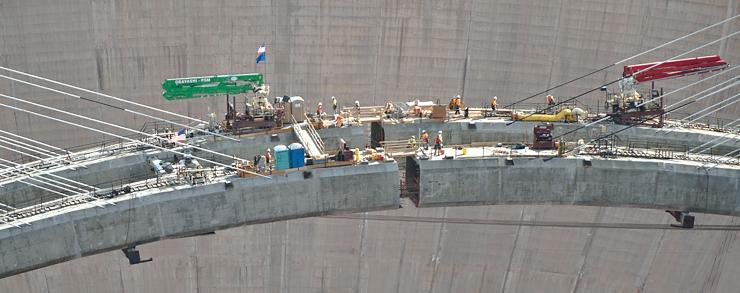
Closeup of the arch as final closure is about to be made - August 2009
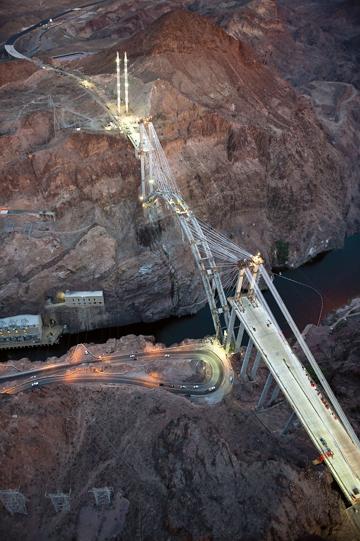
Aerial view of the bridge site as closure of the arch approaches
August 2009
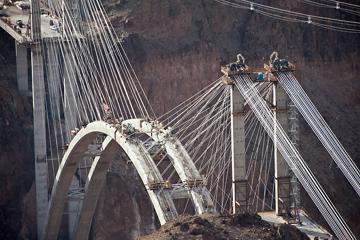
View of the bridge as closure approaches - August 2009
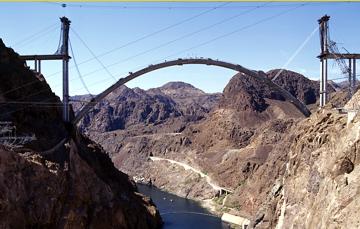
The arch is completed with a majority of the temporary forestays and backstays removed. The temporary pylons for the cable stays remain standing on top of Pier 5 (Nevada) and 14 (Arizona). Utilizing the highline crane, crews remove work platforms from on top of the Arizona pylons. - September 2009
October 2009
Construction of the vertical piers that will support the roadway is underway.
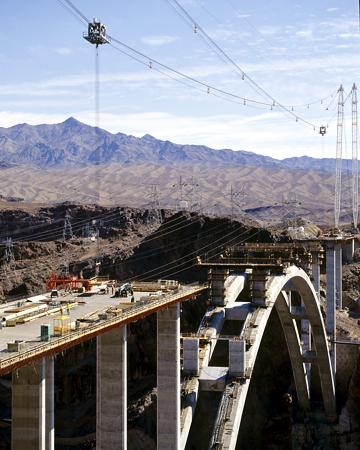
Construction is underway on the vertical piers that will support the roadway above the arch - October 2009
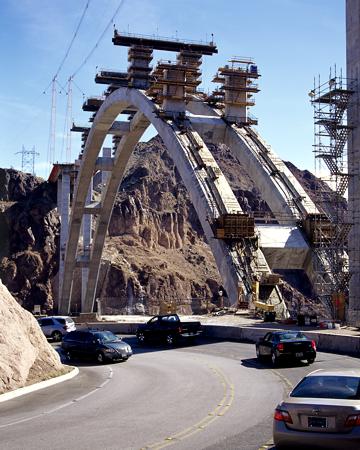
As seen from the existing US 93 hairpin curve in Nevada, pier construction on the arch to support the roadway progresses
October 2009
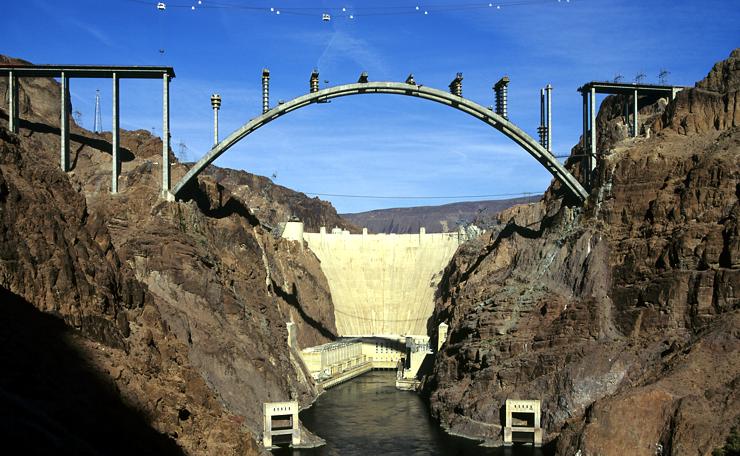
Construction of the piers to support the roadway moves along in November 2009
December 2009
All eight of the vertical piers on the arch were set and capped. At the end of the month the first two of thirty six, 50 ton steel girders were set into place.
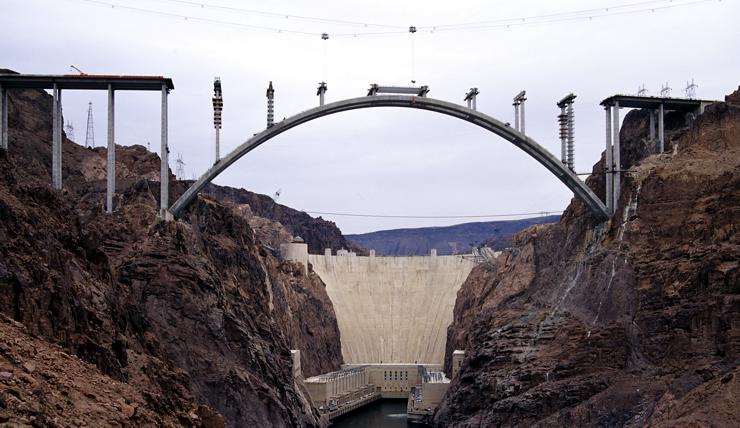
The eight piers to support the roadway are essentially complete and the first two steel girders are in place - December 2009
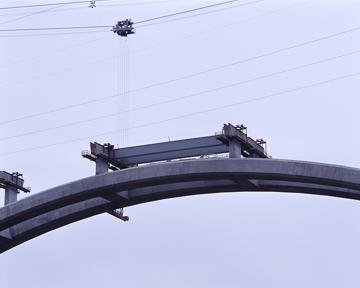
First two 50 ton steel girders are in place - December 2009
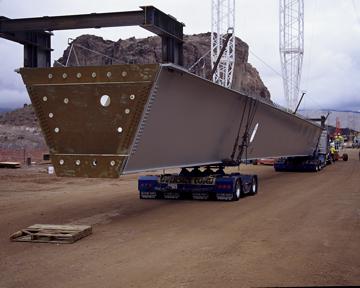
A truck transports a 115 foot long steel girder onto the Nevada approach and waits for off loading - January 2010
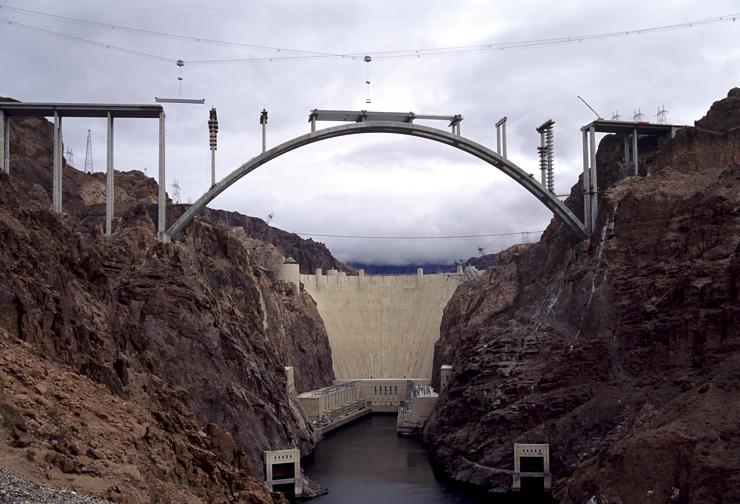
All piers are completed and installation of steel girders is progressing. The north highline crane transports a steel girder out for erection between piers 10 and 11 - January 2010
February 2010
Installation of the steel girders is making steady progress.
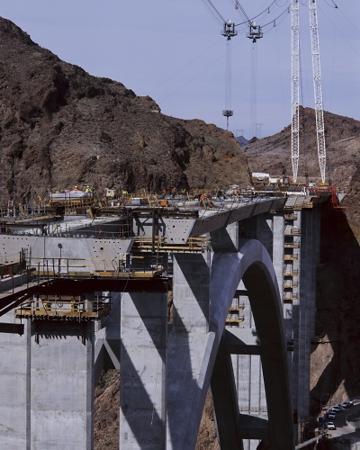
Installation of steel girders using the highline crane is moving along in February 2010
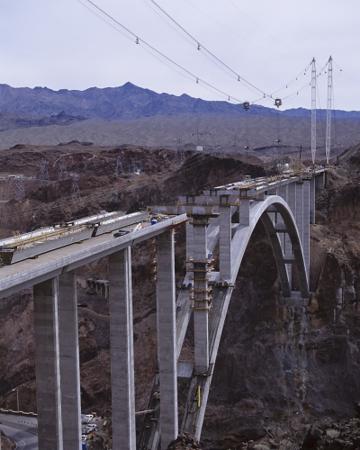
Construction of the bridge deck proceeds in February 2010
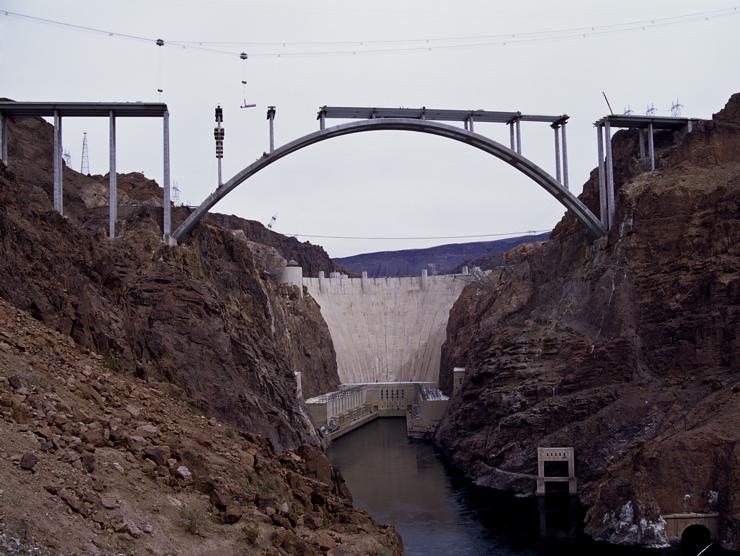
View of the bridge from down stream - February 2010
March 2010
Steel girders are staged on the Nevada approach deck, waiting to be set between the Arch spandrel piers. Stay-in-place steel decking is erected between the girders at spans 10 and 11.
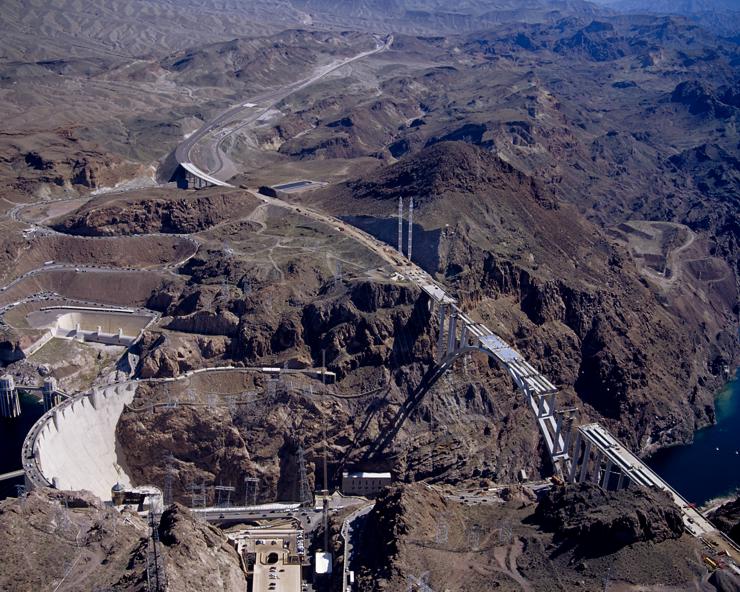
View of the bridge as seen from Nevada towards Arizona. In the background, the Arizona approach roadway is visible - March 2010
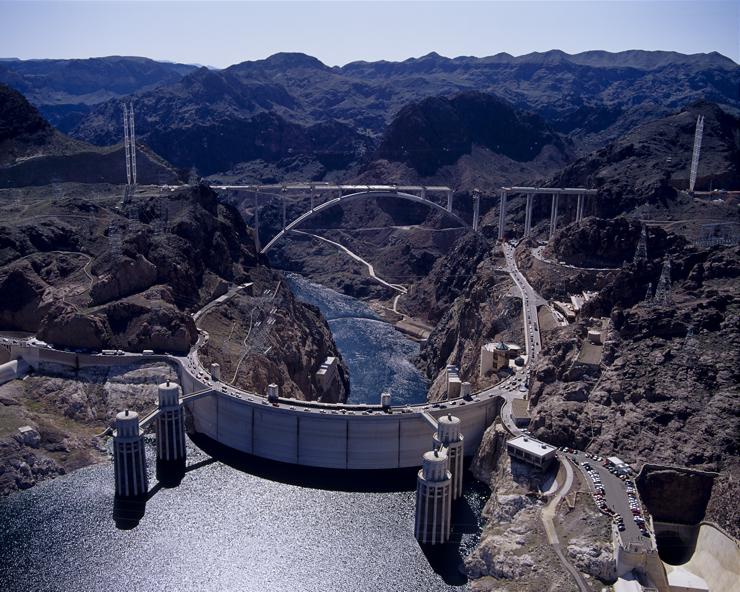
View of the bridge and the new US93 alignment as seen from above Hoover Dam - March 2010
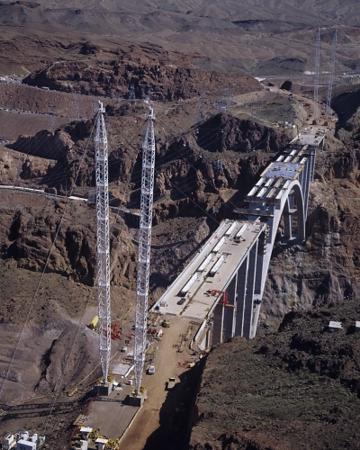
View of the bridge looking north from Nevada towards Arizona
March 2010
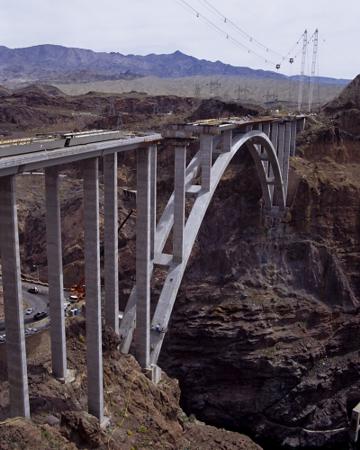
View of the bridge looking north from Nevada towards Arizona
April 2010
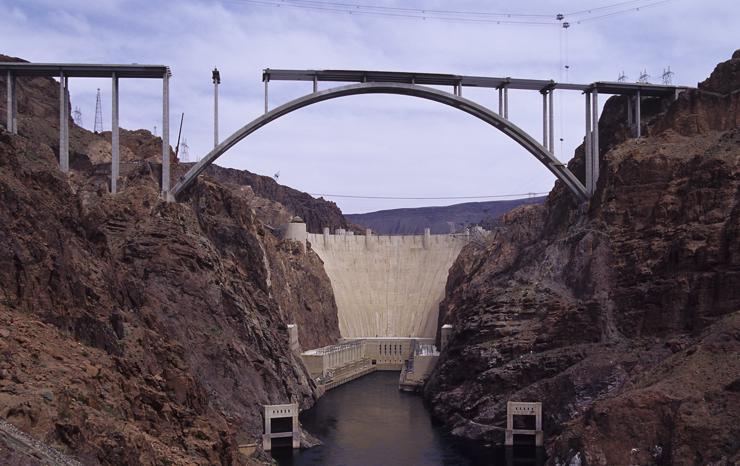
View of the bridge from down stream - April 2010
May-June-July 2010
Completion of the bridge deck has moved steadily ahead. Finishing work on the deck has begun and the bridge is expected to go into service in November 2010.
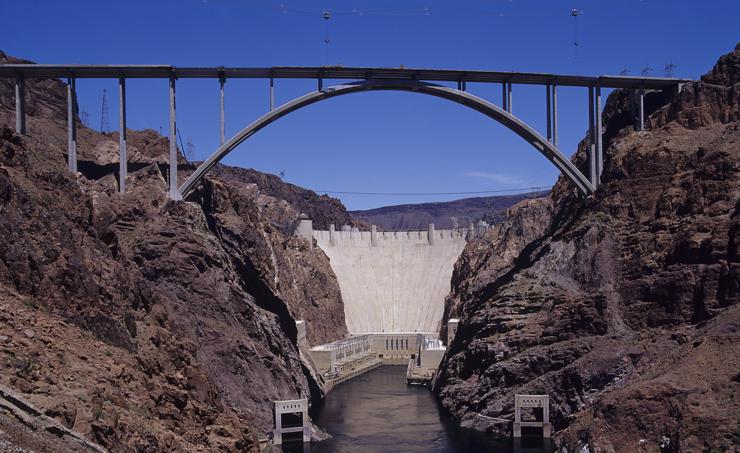
View of bridge from down stream - May 2010
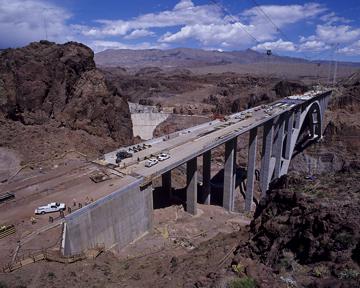
Completion of the deck is moving forward - May 2010
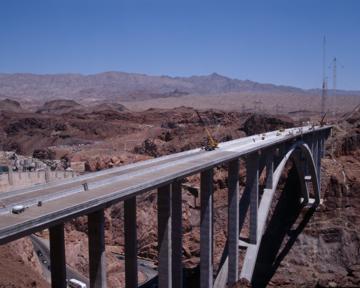
Finishing work has started on the bridge deck - June 2010

View of the bridge from down stream - July 2010
August 2010
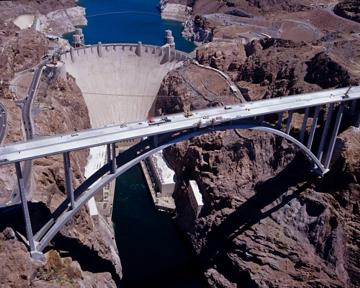
Finishing work continues on the bridge deck - August 2010
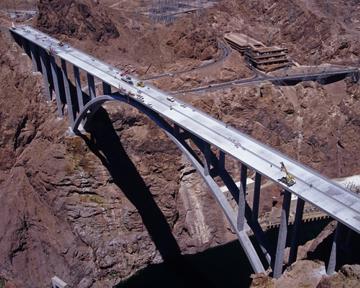
Finishing work continues on the bridge deck - August 2010
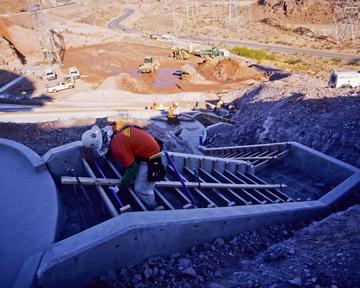
Constructing stairs on alternate route of switchback trail
August 2010
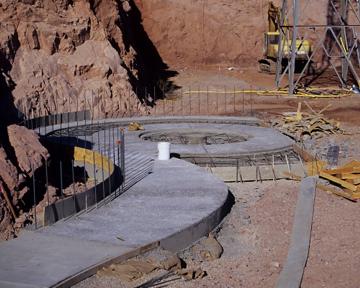
Constructing one of several plazas along the switchback trail
August 2010
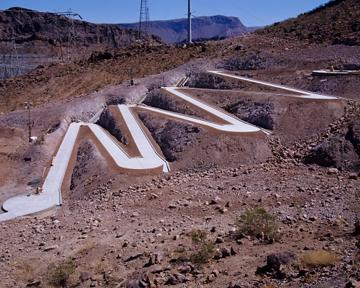
Finishing switchback trail to bridge from visitor parking lot
August 2010
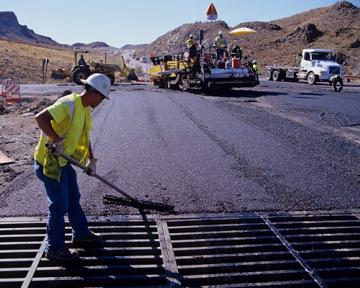
Paving work - August 2010
September 2010
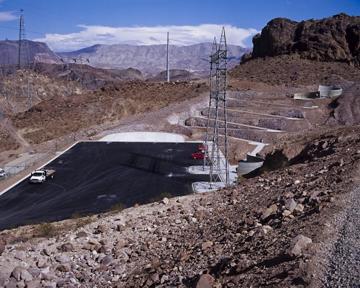
Visitor parking lot and switchback trail to the bridge
September 2010
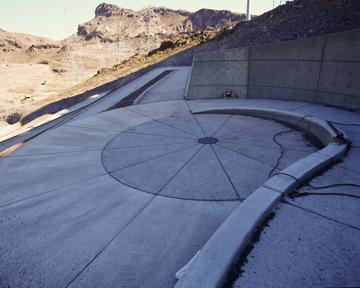
One of the plazas on the switchback trail - September 2010
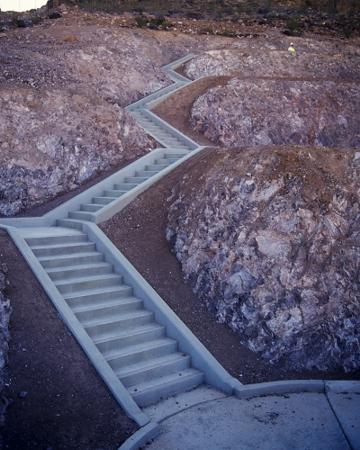
Stairs provide an alternate to the switchback trail
September 2010
October 2010
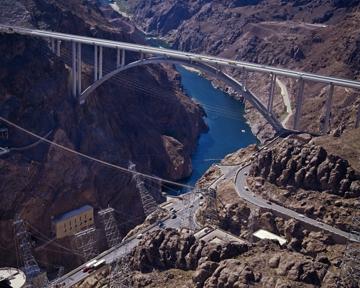
View from Nevada downstream - October 2010
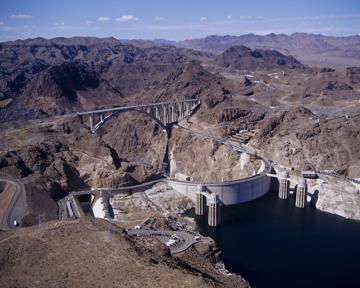
View from Arizona over Hoover Dam - October 2010
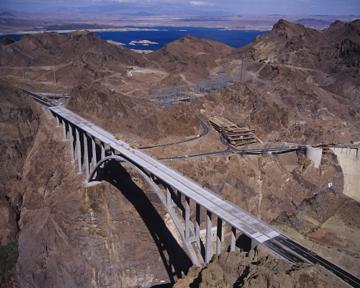
View from Arizona - Lake Mead in background - October 2010
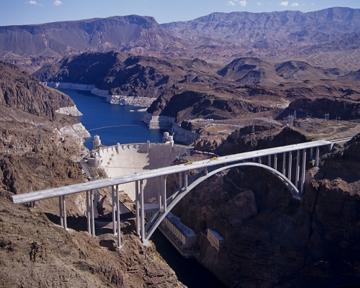
View from Nevada over bridge and Hoover Dam - October 2010
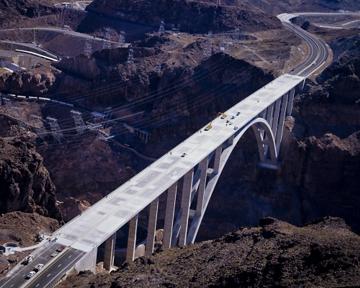
View from Nevada - October 2010
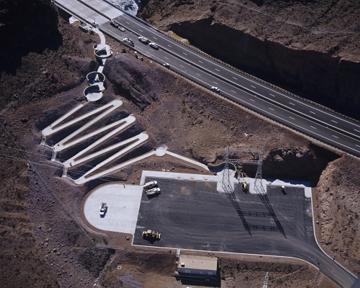
View from Nevada of Visitor Parking and access trail
October 2010
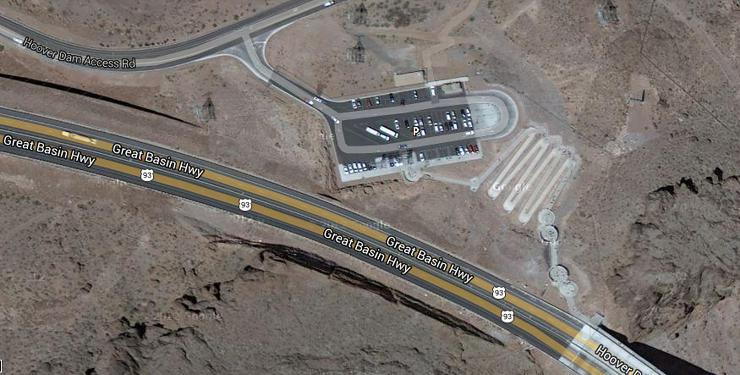
Visitor parking and switchback trail
Bridge completed and opened to traffic. A very complete and extensive photo coverage of this bridge is here on www.highestbridges.com.
The bridge visitors area has a number of Informational Panels explaining the details about the bridge. You can see them here.
The bridge was dedicated on October 14, 2010 with thousands of visitors bussed in from Arizona and Nevada. Read about the dedication ceremonies here.